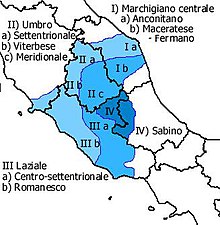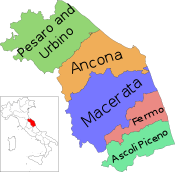Marchigiano dialect
This article needs additional citations for verification. (November 2008) |
| Marchigiano | |
|---|---|
| Marchiscià | |
| Native to | Italy |
| Region | central Marche (provinces of Ancona, Macerata and Fermo) |
Native speakers | 900,000[citation needed] |
| Language codes | |
| ISO 639-3 | – |
ita-cen | |
| Glottolog | None |
| Linguasphere | 51-AAA-okl & 51-AAA-rba |
 | |
Marchigiano refers to a tight cluster of local Romance speech types spoken in the central part of the region Marche, in Italy, in a zone which includes the provinces of Ancona, Macerata and Fermo. It is one of the Central Italian dialect types, and forms part of the typological continuum with and Tuscan. There are notable grammatical, lexical and idiomatic differences between Marchigiano and standard Italian, but it is generally considered, along with the rest of Central Italian dialects, rather intelligible for a speaker of Standard Italian.
In itself Marchigiano is not uniform from town to town, being divided into two main areas:
- The dialect of Ancona (Anconitano), to which the dialects of Osimo, Jesi and Fabriano also belong;
- The dialect of Macerata and Fermo (Fermano-Maceratese), with the inclusion of the variety of the area of Camerino.
Common features[]
The three areas of the Marchigiano dialect are united by some common features which distinguish it from other central Italian languages :
- Italian words stressed on the penultimate syllable ending in no ni or ne undergo apocope in the last syllable. The word contadino (farmer) thus becomes contadì, the word piccioni (pigeons) becomes picciò, and the word cane (dog) becomes cà.[1]
- Italian words ending in -aio change their last syllable to -aro. Fornaio (baker) becomes fornaro.[1]
- The sound [ʎ] (gli) in Italian words is changed to a simple [i]. The word figlio [ˈfiʎʎo] (son) becomes fìio or fio [ˈfi.o].
- Generally the final sound -o in Italian words is changed to -u : fornaio (baker) > fornaru, figlio (son) > fiiu.
- The infinitive ending of Italian verbs loses the final sound -re : amare (to love) > amà, mettere (to put) > mette, morire (to die) > morì.[2]
- The group ng undergoes assimilation to gn : mangiamo (we eat) > magnemo.[2]
- The third-person plural inflection is the same as the singular one. The word ama can mean he (she, it) loves or they love.[2]
The conjugation of to be and to have got at the present indicative tense in the two main dialects is as follows :
| English | Anconitano | Maceratese | Italian | |
|---|---|---|---|---|
| I | am | so | so | sono |
| you | are | sei (sai) | ssi | sei |
| he/she/it | is | è | adè | è |
| we | are | semo | simo | siamo |
| you | are | sé | sete | siete |
| they | are | è(-ne) | adè | sono |
| English | Anconitano | Maceratese | Italian | |
|---|---|---|---|---|
| I | have got | ciò | ciò | ho |
| you | have got | ciài | ci(ài) | hai |
| he/she/it | has got | cià | cià | ha |
| we | have got | ciavémo | ciaìmo | abbiamo |
| you | have got | ciavé | ciaéte | avete |
| they | have got | cià(-ne) | cià | hanno |
Features of the three areas[]
Ancona dialect[]
The Ancona dialect is spoken purely in the town of Ancona and influenced nearby cities (Falconara, Osimo, Jesi, Chiaravalle, Porto Recanati, Loreto and Senigallia) only recently. It has several gallo-italic traits, so it is considered the northernmost central Italian dialect. Particularly, this dialect's speakers always use the article el (the masculine singular, Italian il) unlike standard Italian which in some cases uses lo (the masculine singular). Only the speakers from towns which are closer to Macerata (Osimo, Castelfidardo, Loreto, Porto Recanati) use the article lo as in Italian.[1] These cities also undergo other influences from the Macerata dialect because they are closer to it.[1]
Fabriano dialect[]
The Fabriano dialect is spoken in the town of Fabriano (closer to Umbria) and in the towns closer to it. Rhotacism occurs in this dialect (calza (sock) > carza, fulmine (lightning) > furmine).
Macerata dialect[]
The Macerata dialect is spoken in the provinces of Macerata and Fermo. The speakers of Macerata, to say the, use lu (masculine singular) and lo (neuter singular) . Rhotacism occurs. A lot of assimilations occur:
- nd > nn : mettendo (putting) > mettenno,
- mb > mm : gamba (leg) > gamma,
- nt > nd : pianta (plant) > pianda,
- mp > mb : campo (field) > cambu,
- ld > ll : caldo (hot) > callu.
Vocabulary[]
This section possibly contains original research. (September 2014) |
This section does not cite any sources. (September 2014) |
There follows a list of nouns, verbs and other words from Marchigiano (note that the Anconitano forms of these words have no gemination:[3] babu, ciambòtu, nèrtu, etc.)
- ammò (adv. by this time; now); Anconitano: adè
- babbu (n. dad; father)
- bardasciu or vardasciu (n. boy; child); Anconitano: fiòlo
- bedollu or bidullu (n. poplar)
- brenciu or vrenciu (adj. bitter; sour)
- ciambottu or ciammottu (n. toad/clumsy)
- cuscì (adv. in this way)
- grannola (n. hail)
- (a)lluccà (vb. to shout; to scream); Anconitano: sgagià
- nnertu (adj. thick)
- rosciu or rusciu (adj. red)
- sbisgià or sbiscià (vb. to slide)
- scì (adv. yes)
- jèmmete (n. cliff)
- mata (n. mud)
See also[]
External links[]
Notes[]
- ^ Jump up to: a b c d Massimo Morroni, Vocabolario del dialetto osimano
- ^ Jump up to: a b c Carlo Grillantini, Saggi e studi sul dialetto osimano
- ^ Loporcaro, Michele (1997). "Lengthening and "raddoppiamento fonosintattico"". The Dialects of Italy. Edited by Martin Maiden, Mair Parry. Abingdon: Routledge. ISBN 0-415-11104-8.
Ancona, as claimed by Rohlfs (1966: 322) is the southernmost outcrop on the Adriatic coast - south of Wartburg's La Spezia-Rimini (or Pellegrini's Carrara-Fano) Line - of Western Romance degemination
- Languages with Linglist code
- Dialects of Italian
- Culture in le Marche

